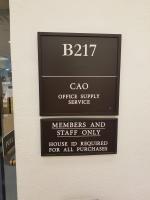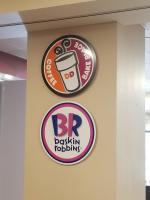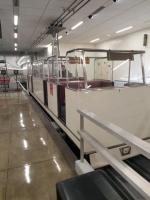Friday, June 22, 2018
By:
On Monday this week, our office interns all arrived excited to start the day. Today we would be going on a scavenger hunt around Capitol Hill! My only experience inside the Capitol Building had been quickly walking through on my way from the House to the Senate for a hearing last week and I was excited to see some of the art, history, and architecture of the U.S. Capitol. Our intern coordinator handed us our list, with instructions to be back by 1:30, and three hints we could text her for if we got stuck, and we were on our way!

We started out easy. Our first three hints were all within the House Office Buildings. “I need 150 black ball point pens – where do I go?” I had no idea, but one of the other interns, Rohni, remembered there was an office  supply store in the House somewhere. We ended up at Longworth and on the way to the office supply store saw a sign on the wall for Coffee/Ice Cream, our next clue – “A place to stop for ice cream.” We arrived at the Dunkin Donuts/Baskin Robins, ready to get some ice cream (it was in the 90s that day!) only to be told they don’t serve ice cream until 11am. What a disappointment, oh well.
supply store in the House somewhere. We ended up at Longworth and on the way to the office supply store saw a sign on the wall for Coffee/Ice Cream, our next clue – “A place to stop for ice cream.” We arrived at the Dunkin Donuts/Baskin Robins, ready to get some ice cream (it was in the 90s that day!) only to be told they don’t serve ice cream until 11am. What a disappointment, oh well.

We headed to our next stop – the Rayburn to Capitol train. Did you know that if you go to the basement of the House Office Buildings, they are all connected by tunnels? There is also an underground train that connects the House Buildings to the Capitol Building. This makes it quick and easy for Congress Members and staff to get around when they are needed for hearings and votes.

We got off the train, and headed upstairs to the Capitol Building. We had a long list of clues to find here. Some were easy. We quickly found Democratic Whip Steny Hoyer’s office. Congressman Hoyer is from my home district – MD 5, so I felt extra excited about seeing his office at the Capitol. The straight forward ones we had no trouble with. The House Committee on Rules, the Cloak Room, and The Speaker’s Balcony were all pretty simple to find, though we were all disappointed that we weren’t allowed to actually go out onto the Speaker’s Balcony – you apparently must be accompanied by staff to do that.
 We made our way to the Old Supreme Court Chamber to see what we could find there. The Old Supreme Court Chamber is the first room constructed for the use of the nation's highest judiciary body and was used by the Court from 1810 until 1860. It is no longer in use, but has been restored to its original state. It is a beautiful room with plush red carpeting and vaulted ceiling. On the back wall of the room is where we found the answer to our next clue, “If you’re not five minutes early, you’re late.” The Old Supreme Court Clock is set five minutes fast. This was a practice started in the 1800’s to help ensure the punctuality of
We made our way to the Old Supreme Court Chamber to see what we could find there. The Old Supreme Court Chamber is the first room constructed for the use of the nation's highest judiciary body and was used by the Court from 1810 until 1860. It is no longer in use, but has been restored to its original state. It is a beautiful room with plush red carpeting and vaulted ceiling. On the back wall of the room is where we found the answer to our next clue, “If you’re not five minutes early, you’re late.” The Old Supreme Court Clock is set five minutes fast. This was a practice started in the 1800’s to help ensure the punctuality of 
 building, the black cat roams the halls of the basement of the Capitol at night, and appears to visitors and staff before historic or tragic national events. Or perhaps the paw prints are simply from one of the resident rat catchers that walked through the cement as it was being set, who’s to say? Up above us, we saw Benjamin Henry Latrobe’s Corncob Columns. Latrobe was honored as the second Architect of the Capitol, having designed the original Hall of the House, the Old Senate Chamber, and the Old Supreme Court Chamber. He created the Corncob Columns in representation of America’s agriculture.
building, the black cat roams the halls of the basement of the Capitol at night, and appears to visitors and staff before historic or tragic national events. Or perhaps the paw prints are simply from one of the resident rat catchers that walked through the cement as it was being set, who’s to say? Up above us, we saw Benjamin Henry Latrobe’s Corncob Columns. Latrobe was honored as the second Architect of the Capitol, having designed the original Hall of the House, the Old Senate Chamber, and the Old Supreme Court Chamber. He created the Corncob Columns in representation of America’s agriculture.
Right above the Old Supreme Court is the Old Senate Chamber. Being inside the chamber was like stepping into the past.

 It was absolutely gorgeous, having been restored into somewhat of a museum, recreating the scene of many significant moments in the evolution of the United States Senate and the legislative history of the nation. We were able to find another clue in the room – Washington’s Porthole Portrait. The 1823 portrait was painted by Rembrandt Peale, who had painted Washington from life, and was purchased in 1832, the centennial of Washington’s birth, to be displayed in the Chamber.
It was absolutely gorgeous, having been restored into somewhat of a museum, recreating the scene of many significant moments in the evolution of the United States Senate and the legislative history of the nation. We were able to find another clue in the room – Washington’s Porthole Portrait. The 1823 portrait was painted by Rembrandt Peale, who had painted Washington from life, and was purchased in 1832, the centennial of Washington’s birth, to be displayed in the Chamber.
We arrived at the National Statuary Hall, a large tow-story chamber within the Capitol that houses statues of prominent Americans. There were all sorts of stunning statues, from Rosa Parks to St. Junipero Serra to Thomas Edison. There were several statues on our list, but found none of them in the main Statuary Hall. What we did find out was that this used to serve as the main Hall of the House, redesigned after the fire of 1814. Members sat at desks arranged in tiered, semi-circular rows, facing the Speaker’s rostrum. The Speaker’s rostrum, a tiered wooden structure, occupied the flat side of the semi-circular room. The acoustics in the room were designed to allow the Speaker to be heard clearly from all around the room, however as a side effect, sounds reverberated throughout the room from all over. There are spots within the Hall where you can whisper and be heard clearly from the other side. On the tiled floor of the chamber, you can find brass plaques placed where each original Member’s desks were.  This was our best guess for one of our clues – Lincoln was here. We also found the plaque of John Quincy Adams, which was another clue on our list – John Quincy Adams opened this door and never came out. Adams suffered a stroke on the House floor, collapsing right at his desk during a debate on Military Affairs. He was taken to the personal chambers of the Speaker of the House (now the Lindy Boggs Congressional Women’s Reading Room), where he slipped into a coma and died two days later. We didn’t get to go into the room, but a Capitol staff member told us that the original couch that Adams died on is still preserved in the room.
This was our best guess for one of our clues – Lincoln was here. We also found the plaque of John Quincy Adams, which was another clue on our list – John Quincy Adams opened this door and never came out. Adams suffered a stroke on the House floor, collapsing right at his desk during a debate on Military Affairs. He was taken to the personal chambers of the Speaker of the House (now the Lindy Boggs Congressional Women’s Reading Room), where he slipped into a coma and died two days later. We didn’t get to go into the room, but a Capitol staff member told us that the original couch that Adams died on is still preserved in the room.
Next we went in search of more of the statues on our list. With the help of a Capitol Security Officer, we made our way to the Capitol Visitors Center, where we saw the statues for three more clues on our list: the first female Representative, Jeanette Rankin; the only statue of a child in the Capitol, Hellen Keller; and someone who has been in space, John L. Swigert, Jr., an astronaut on the Apollo 13 mission.



 We headed back upstairs, where we found the Flight 93 Memorial, another clue on our list. The plaque is in memory of the passengers and crew of United Airlines Flight 93, whose brave sacrifice on September 11, 2001, not only saved countless lives but may have saved the U.S. Capitol from destruction.
We headed back upstairs, where we found the Flight 93 Memorial, another clue on our list. The plaque is in memory of the passengers and crew of United Airlines Flight 93, whose brave sacrifice on September 11, 2001, not only saved countless lives but may have saved the U.S. Capitol from destruction.
Our time was starting to run out, so we asked for help from Capitol Tour Guides for some more of our clues. One showed us the staircase the president uses before inauguration, telling us how the helicopter lands outside and the incoming President ascends the steps into the building.
 Another tour guide directed us to the second floor rotunda where we could find a statue in with a part of the Berlin Wall in it. We came upon Ronald Reagan’s statue, famously quoted as saying “Tear down this wall!” in a speech he made in Berlin on June 12th, 1987. At the base of the statue, there is a strip of stone embedded which was acquired from the demolished Berlin Wall.
Another tour guide directed us to the second floor rotunda where we could find a statue in with a part of the Berlin Wall in it. We came upon Ronald Reagan’s statue, famously quoted as saying “Tear down this wall!” in a speech he made in Berlin on June 12th, 1987. At the base of the statue, there is a strip of stone embedded which was acquired from the demolished Berlin Wall.  We next went to the first floor rotunda for our next clue – Washington was supposed to be buried here, but he’s missing. In the center of the rotunda floor, there is a star which designates the spot where Washington’s tomb was built two floors below. The original design included a glass floor so the tomb could be viewed from above by the public, but this was never implemented as Washington’s will stated his body to be entombed at his estate, Mount Vernon.
We next went to the first floor rotunda for our next clue – Washington was supposed to be buried here, but he’s missing. In the center of the rotunda floor, there is a star which designates the spot where Washington’s tomb was built two floors below. The original design included a glass floor so the tomb could be viewed from above by the public, but this was never implemented as Washington’s will stated his body to be entombed at his estate, Mount Vernon.
We only had a couple clues left to find. One of them was simply the quote “Join or die.” We knew of Benjamin Franklin’s political cartoon emphasizing the importance of colonial unity, but no one we talked to could think of anything in the Capitol that related to it. We texted our intern  coordinator Cassie for a hint, who told us to go past the Hall of Columns, and look up. We made our way to the Hall of Columns in the House side of the Capitol, but still weren’t really sure what we were looking for. We didn’t end up finding whatever this clue was referring to, but we did find the statue of Father Damien. Father Damien was a Roman Catholic priest from Belgium, who devoted his life to a leper colony on Molokai in Hawaii. He dedicated 16 years to the colony, building chapels and homes for children, caring for those in the colony, and holding Mass every morning, until he died of Leprosy himself in 1884. In 2009 he was elevated to sainthood by Pope Benedict XVI.
coordinator Cassie for a hint, who told us to go past the Hall of Columns, and look up. We made our way to the Hall of Columns in the House side of the Capitol, but still weren’t really sure what we were looking for. We didn’t end up finding whatever this clue was referring to, but we did find the statue of Father Damien. Father Damien was a Roman Catholic priest from Belgium, who devoted his life to a leper colony on Molokai in Hawaii. He dedicated 16 years to the colony, building chapels and homes for children, caring for those in the colony, and holding Mass every morning, until he died of Leprosy himself in 1884. In 2009 he was elevated to sainthood by Pope Benedict XVI.
 We were out of time, and didn’t get to look for the last item on our list, it wasn’t until later that I found it in a Rayburn vending machine. One Big Az Burger. I was almost tempted to get one and try it, but thought I better not risk it.
We were out of time, and didn’t get to look for the last item on our list, it wasn’t until later that I found it in a Rayburn vending machine. One Big Az Burger. I was almost tempted to get one and try it, but thought I better not risk it.
I was so glad we got to opportunity to do the scavenger hunt. I learned so much about the history of the Capitol, got to bond with the other office interns, and had a lot of fun. (I also well surpassed my steps goal for the day!) I’m really looking forward to the upcoming intern tour so I can share some of this experience with all the other SPS Interns.
Sarah Monk
